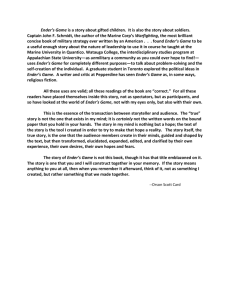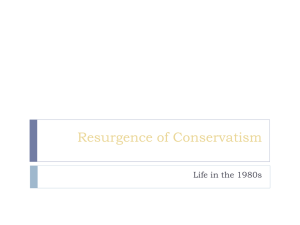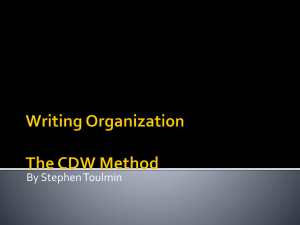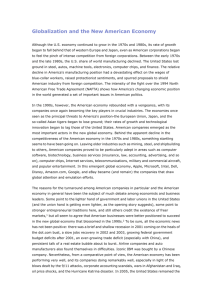Ender's Game - Lakewood High School
advertisement
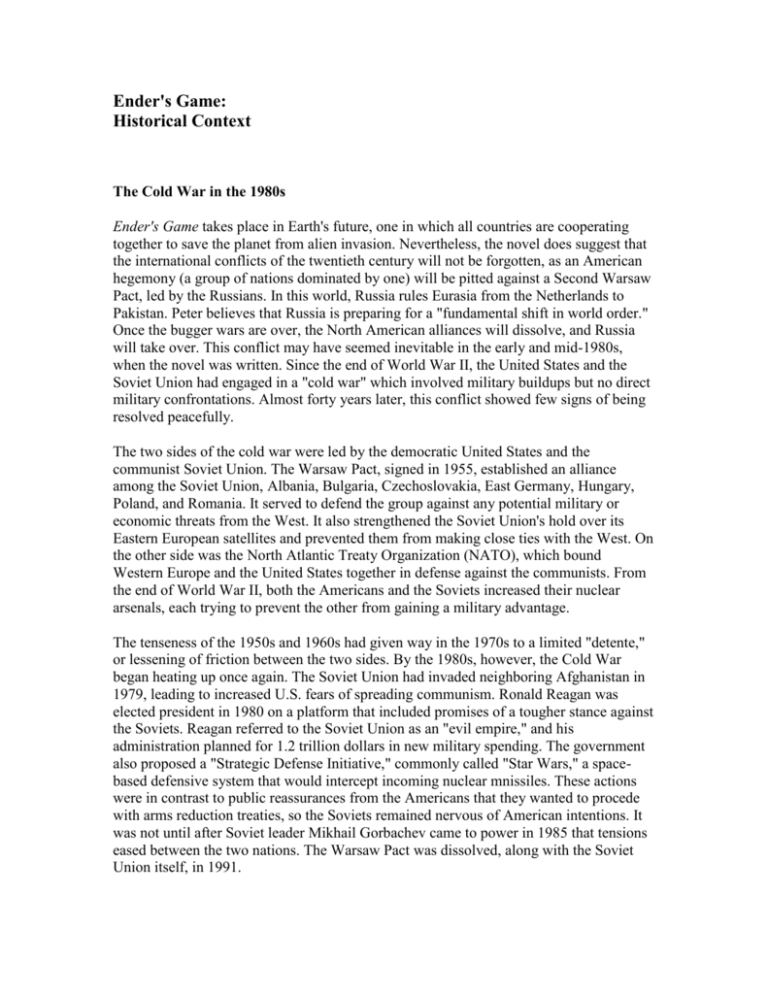
Ender's Game: Historical Context The Cold War in the 1980s Ender's Game takes place in Earth's future, one in which all countries are cooperating together to save the planet from alien invasion. Nevertheless, the novel does suggest that the international conflicts of the twentieth century will not be forgotten, as an American hegemony (a group of nations dominated by one) will be pitted against a Second Warsaw Pact, led by the Russians. In this world, Russia rules Eurasia from the Netherlands to Pakistan. Peter believes that Russia is preparing for a "fundamental shift in world order." Once the bugger wars are over, the North American alliances will dissolve, and Russia will take over. This conflict may have seemed inevitable in the early and mid-1980s, when the novel was written. Since the end of World War II, the United States and the Soviet Union had engaged in a "cold war" which involved military buildups but no direct military confrontations. Almost forty years later, this conflict showed few signs of being resolved peacefully. The two sides of the cold war were led by the democratic United States and the communist Soviet Union. The Warsaw Pact, signed in 1955, established an alliance among the Soviet Union, Albania, Bulgaria, Czechoslovakia, East Germany, Hungary, Poland, and Romania. It served to defend the group against any potential military or economic threats from the West. It also strengthened the Soviet Union's hold over its Eastern European satellites and prevented them from making close ties with the West. On the other side was the North Atlantic Treaty Organization (NATO), which bound Western Europe and the United States together in defense against the communists. From the end of World War II, both the Americans and the Soviets increased their nuclear arsenals, each trying to prevent the other from gaining a military advantage. The tenseness of the 1950s and 1960s had given way in the 1970s to a limited "detente," or lessening of friction between the two sides. By the 1980s, however, the Cold War began heating up once again. The Soviet Union had invaded neighboring Afghanistan in 1979, leading to increased U.S. fears of spreading communism. Ronald Reagan was elected president in 1980 on a platform that included promises of a tougher stance against the Soviets. Reagan referred to the Soviet Union as an "evil empire," and his administration planned for 1.2 trillion dollars in new military spending. The government also proposed a "Strategic Defense Initiative," commonly called "Star Wars," a spacebased defensive system that would intercept incoming nuclear mnissiles. These actions were in contrast to public reassurances from the Americans that they wanted to procede with arms reduction treaties, so the Soviets remained nervous of American intentions. It was not until after Soviet leader Mikhail Gorbachev came to power in 1985 that tensions eased between the two nations. The Warsaw Pact was dissolved, along with the Soviet Union itself, in 1991. Science and Technology in the 1980s One of the most startling technological revolutions of the 1980s was the growth of the personal computer. While large mainframe computers had been in use for many years, they were mainly limited to large research facilities. Advances in design made computers smaller and more affordable, and computers became available to a broad spectrum of businesses and individuals. Apple Computer introduced the Apple II, a system designed for home use, in 1977, while IBM countered with the PC (personal computer) in 1981. "Computer literacy" — a familiarity with how computers worked — became a coveted skill among workers, and schools began offering classes in programming. In 1980 there were only 100,000 computers in schools throughout the United States; by 1987, that number had increased to more than two million. In addition, the internet of the 1980s was just a loosely organized system that helped academics and researchers send messages to each other; it was only in the mid-1990s that it became a powerful media available to any home with a computer and a modem. The use of computer games, simulations, school programs, and "nets" in Ender's Game reflects the growing influence that computers were coming to have in the 1980s. A technological revolution was also happening on the biological frontier during the 1980s. Technical advances in the 1970s had led researchers to better understand how an organism's DNA (deoxyribonucleic acid) influences its development. In the 1980s, scientists began applying that knowledge to manipulate the genetic makeup of organisms to create new and improved strains of plants and animals. While this "genetic engineering" led to more productive, disease-resistant crops, people worried about its possible application to humans. The world's first "test-tube baby" — a baby conceived outside its mother's womb — had been born in 1978, and the first U.S. clinic opened two years later. If people could now use science to aid conception, critics wondered, might they not also use it to create babies with "designer genes"? Moral issues surrounding the birth of children also figure in Ender's Game, as Ender's character seems to be a deliberate combination of his two older siblings, ordered by the government to produce the military genius they need. Religion in the 1980s The 1980s saw people searching for ways to re-establish traditions in their homes and lives. The 1960s and 1970s had been a time of experimentation and free-style living, and church attendance declined as people began exploring spirituality outside the bounds of organized religion. In the 1980s, however, many individuals wanted a return to a simpler existence, one in which there were fewer surprises. They wanted to be able to believe in something that was never-changing, something dependable around which to structure their lives. Religious conservatives, who became prominent in the 1980s, offered one route toward accomplishing that goal. Increase in fundamentalist faiths increased in the 1980s: a Gallup poll in 1986 showed thirty-one percent of respondents classified themselves as evangelical or "born-again" Christians. This increase was reflected in a growing conservative Christian political movement, which sought to bring moral issues more into the political mainstream. For many people, however, religion became more of a personal expression, and this was reflected in the growth of the "New Age" movement. Interestingly enough, the world of Ender's Game is a world where one's religion has become a matter for embarrassment or even persecution. Both of Ender's parents have had to renounce their faith in order to conform; Alai's whispered "Salaam" similarly seems something outlawed. Ironically, however, this persecution seems to have made their faith even more precious to the characters. The background of Card's own faith, Mormonism, includes its own bouts of persecution. The Church of Jesus Christ of Latter-Day Saints was founded in New York in 1830 by Joseph Smith, who published the divine revelations he claimed to have received in The Book of Mormon. The most controversial of Smith's precepts was the practice of polygamy, and Smith and his followers were driven out of communities in New York, Ohio, Illinois, and Missouri. A large Mormon settlement was established in Utah in 1847 by Smith's successor, Brigham Young, but they continued to be feared and mistrusted by outsiders, including the federal government. The Edmunds-Tucker Act of 1887 dissolved the Mormon Church as a corporate entity, and their leaders had to renounce polygamy before Utah could gain its statehood in 1896. Since then, the Mormon Church has increased ties with more mainstream faiths and has grown considerably; by the end of the 1980s, membership within the church had risen to over seven million members. Nevertheless, Mormons still sometimes suffer prejudice from outsiders who stereotype them or misunderstand their beliefs. Understanding this background can provide an interesting insight into the way religion is portrayed in Ender's Game.
